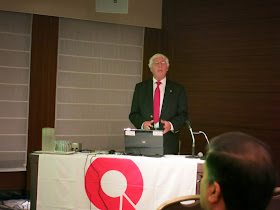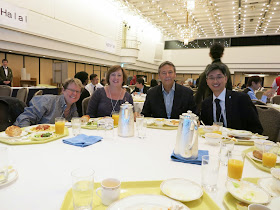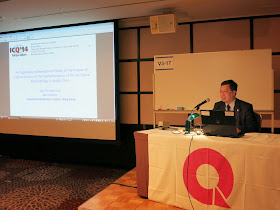The first speaker in session of Risk Management, Reliability and Safety was Prof. Sadao Komermushi (Supreme Adviser, Food Safety Network and Visiting Professor, Osaka City University) and his talk named “How to get food safety and food defense? It starts from Food hygiene 7S”. Prof. Komermushi explained that Prerequisite Program (PRP) was only written item name in ISO 22000 but details were written in PAS220 & ISO/TS 22002-1, then he introduced a new food safety management system named FSSC 22000.
The following diagram showed the relationship among HACCP, ISO 22000 / FSSC220000 and ISO 9001 which systems were from food hygiene and safety to management. Then Prof. Komermushi introduced Food Hygiene 7S which aimed at developing food safety systems
1S – Seiri (Sorting out)
2S – Seiton (Systematic arrangement)
3S – Seisou (Sweeping)
4S – Senjyou (Scrubbing)
5S – Sakkin (Sterilization)
6S – Shituke (Self-discipline)
7S – Seiketsu (Standardizing Cleanliness)
The concept of Food Hygiene 7S was shown in the following diagram. Then Prof. Komermushi briefed some cases of food terrorism and defense in Japan. He used Meng-Zi and Xun-zi theories to explain the view of human nature as fundamentally good or bad respectively. Finally, he concluded Food Hygiene 7S were useful for food hygiene and safety. Furthermore, it should be work more on food defence.
During the break, we meet our UK and Singapore friends and took a photo for memory. Mr. Jan Gillett gave me his new book with sign. (Left: Mr. Ivan Ng (HKSQ), Mr. Jan Gillett (PMI), I and Mr. Kenneth Leung (Chairman, ANQ & SQI))
Prof. Dr. Yuri Gusakov (VP of ROQ) and I took a photo. (ANQ Congress 2017 might be held in Russia!)
I also took a photo with Prof. Kano and Mr. J. Ravikant (Associate Vice President & Head TQM, SRF).
Then we went to the session of Business Strategy and TQM Strategy and Policy Management to attend Prof. Yoshinori Iizuka (Professor Emeritus, The University of Tokyo) talk entitled “Quality Management for Sustained Success – Its Fundamental Concepts and Genuine Quality Management”. Prof. Iizuka said sustained success in business should focus on customer value provision.
Then Prof. Iizuka explained the quality in business management and briefed some key concepts in customer value provision included capabilities and characteristics of organization. This whole picture could be found in the following diagram. One of key important things is “Adaptability to Change”. Prof. Iizuka called it as Genuine Quality Management model. At the end, he concluded four conditions for sustained success and they were “Customer value provision”, “Competitive advantage”, “Systematization” and “Adaptability to changes”.
After that we attend IAQ Session with the theme “IAQ’s contribution to Innovation through Quality” at International Conference on Quality”.
The first speaker was Mr. Janak Mehta (President, IAQ) and his topic named “A community of the world’s leading executives, practitioners and academics dedicated to promoting the cause of quality”. Mr. Mehta briefed the key contributors to the IAQ and founding members included AV Feigenbaum (ASQC), Kaoru Ishikawa (JUSE) and Walter Wasing (DGQ) and others included George Box (ASQC), Tetsuichi Asaka (JUSE), Genichi Taguchi (JUSE), Lennart Sandholm (SIQ), Hans Dieter Seghezzi (EOQ), Noriaki Kano, JUSE and many more.
The following diagram was discussed the distribution of academicians in the world and related to GDP per Capita. Mr. Mehta said the IAQ way was Quality for Humanity and introduced various initiatives for innovative approaches included Education (UNESCO), Healthcare, Sustainability, Innovation, etc. Finally, he stated there were four academicians were sharing today their experiences towards “Innovation Through Quality”.
The second speaker was Anc. A. Blanton Godfrey (Distinguished University Professor, College of Textiles, North Carolina State University) and his topic was “Entrepreneurship, Quality and Innovation”. Prof. Godfrey said three typical reasons for being an entrepreneur were Job Creation, Innovation and Wealth Creation. He quoted The Economist that “Innovation is now recognized as the single most important ingredient in any modern economy.” and quoted Jack Welch statement that “Innovate or die!”, as well as Bell Labs President – Mervin Kelly who said that “Better or Cheaper, or Both.”
Prof. Godfrey pointed out that Entrepreneurs would like to solve problems, create something new & something insanely great, build something that will last a legacy and change the world. He also explained three factors driven innovation that were Technology, Problems and Opportunities. Prof Godfrey mentioned the error proofing was a key innovation tool to improve work operations including materials, machines and methods, with the aim of preventing problems due to human error. It needed to change from “Improve Human Beings fit to Work Operations” to “Improve Work Operations fit to Human Beings”. The following diagram showed the principles of error proofing.
Acn. Chao-Ton Su (Chair Professor, IEEM Dept., National Tsing Hua University, Taiwan) was the third speaker and his presentation entitled “Innovation through the Use of Quality Concept and Techniques”. He said quality is the only way to excellence. There were four major systems included ISO 9001, TQM, Six Sigma and NQA/Business Excellence Model.
Then Prof. Su said Innovation is about creating the future (thinking about tomorrow’s customer). However, it was difficult to clearly distinguish the results of improvements and innovations. Both concepts “Quality through Innovation” or “Innovation through Quality” were in some ways mutually dependent. Based on literature reviews and examples, Prof. Su concluded that implementing ISO 9001/TQM would be successful in innovation; Six Sigma / DFSS could be considered as a systematic way for innovation.
Acn. Pal Molnar (IAQ Board Member) was the fourth speaker and his talk was “Quality through Innovation”. His presentation included three parts included “Driving Forces of Changing World”, “Quality Development by Innovation – the Success Factor” and “Breakthrough by Innovation: Increasing of Competitiveness”.
Dr. Pal Molnar said all innovation started with a consumer insight that was a focused understanding of unfulfilled needs, problems, wants or desires. Traditionally, style of management in the innovation and quality are conflicted. Quality tried to stable of the process, but innovations tried disturbing a stabile situation. However, we needed both for market. Therefore, Harmony is the key word. He said development of quality level needed to change through large jumps and small steps. Then he discussed some success factors for innovation included “People”, “Leadership”, “Culture of Innovation”, “Company Strategy” and “Organization”.
The fifth speaker was Anc. Lars Sorqvist (President, Sandholm Associates; Associate Professor, Royal Institute of Technology; VP, IAQ) and his topic named “Quality and Innovation in New Product Development”. In the beginning, Dr. Lars Sorqvist briefed different general problems in product development such as fast changes, globalization, short product lifetime, etc.
The he pointed out some improvement points to be focused for solving new product development’s problems included “Customer focus”, “Cross Functional Integration (Knowledge Transmission)” , “Organization Structure”, “Develop the Design Flow” and “Management Commitment”.
The last speaker was Prof. Noriaki Kano and his gave a conclusion of IAQ session through his Innovation Map.
Firstly, Prof. Kano showed us the objective of TQM in the 21st Century. He said quality for cost was in the 20th century but quality for sales would be for the 21st Century.
Then Prof. Kano explained the structure of Q1, Q2 and Q3 as Qualities of Past, Present and Future. Moreover, he also asked the IAQ members in the meeting through the structuring of A, Q1, Q2, Q3, P and others.
Lunch with Prof. Kazuyuki Suzuki (Professor, Dept. of Informatics, University of Electro-Communications, Tokyo) and he received The Deming Award for Individual in 2014.
(Left: Mr. Roland K. Jahnke (Director Deutsche Post DHL), I (HKSQ), Prof. Suzuki, Prof. Fugee Tsung (HKUST) and Mr. Ivan Ng (HKSQ))
(Left: Ms. Kristin L. Case (P.E. ASQ SSMBB), Ms. Beth Cudney (Asso. Professor & Director of Design Engineering Centre, Missouri University of Science and Technology), Mr. Roland K. Jahnke and I)
I met Dr. Eric Janssens (Director General, EOQ) and we took a photo for memory.
Then I also met Mr. Metha and Prof. Dr. Pal Molnar (Scientific Advisor, Faculty of Engineering, Univeristy of Szeged).
I attended Mr. Ivan Ng’s session and took a photo with Session Chair – Mr. Kazuo Ishiyama (Master Black Belt, Six Sigma Quality Laboratory).
Mr. Ivan C.K. Ng (Capstone Enterprise, HK) was the first speaker in the Six Sigma session and his presentation entitled “An Organization Development Study of the Impact of Cultural Factors on the Implementation of the Six Sigma Methodology in South China”.
In his study, there were three hypothesis to be tested.
1. Six Sigma Implemetation positively related to Objectives, Planned Activities and Actions.
2. Six Sigma quality culture outcomes positively affected by culture of supportiveness, performance, rewards, competitiveness and innovation.
3. Six Sigma efficiency outcomes positively affected by culture of supportiveness, performance, rewards, competitiveness and innovation.
The following was concept map of organization development by six sigma.
Mr. Ivan Ng conducted multiple individual interview from South & East China and then performed online survey (Population: 1273 and Response Rate: 9.1%). He concluded that quality culture and effective factors were supportive but innovative culture was negative. Innovative mindset (software side) was observed not to take into account in the process and its improvement process in Six Sigma. Nevertheless, Chinese values should not be taken as a strong convincing element for arguing against implementing the Six Sigma.
Then Prof. Kano asked a question “What is the culture different between Hong Kong and China?” Ivan replied that it was not the research focus but it could be observed from the result indicating that Hong Kong people culture was more adopt western one.
The second speaker was Mr. Chola Mwitwa (KAIZEN Institue of Zambia) and his topic named “KAIZEN programme Promotion in Zambia”. Mr. Chola Mwitwa said Zambia had attained new economic status in the global setting. KAIZEN is one of proven problem solving instruments that would help to sustain the momentum. Since government and JICA kicked start the National KAIZEN Project to help Zambia development included Promotion Activities, KAIZEN Action Plan – 5W1H, Fact Data Analysis KPI, KAIZEN Conference, etc.
Then I attended Prof. Hiroshi Osada (Tokyo Institute of Technology) talk entitled “Evaluation method of QM System for sustainable growth of the Enterprise”. Prof. Osada’s study aimed to positioning the company’s QMS (e.g. QMS ranking) and recognition of strength & weakness of QMS through periodical evaluation.
Prof. Osada designed questionnaire survey of QMS for 1 year and target listed manufacturing companies in Japan through Six main factors for evaluation. They were separated into two parts below.
Part A: Company-wide QMS (Consolidated base)
- Commitment of top management
- Quality education and human resource development
- Infrastructure of QM
Part B: QMS in core business or core product
- Day to day management and improvement
- Correspondence to customer and Quality Assurance
- New product development
Finally, Prof Osada’s conclusion included strategic QMS according to globalizsation, decreasing quality loss cost and management innovation in NPD (higher value added).
After that I took a photo with Prof. Osada and friends from Ethiopia.
(Left: I, Mr. Bekalu Worku (Directorate, Director of Higher Education Capacity Building; Ethiopian KAIZEN Institute), Prof. Hiroshi Osada, and Mr. Getahun Taddese (Director General, Ethiopian KAIZEN Institute)
After break, we attended Dr. Lars Sorqvist (IAQ, Sweden) session and his presentation named “Future development of the quality profession”. Dr. Sorqvist briefed the development of quality movement from 1920 to 2000. He said it was an evolution not a revolution!
Then Dr. Sorquvist tried to answer what roles of quality management. He consolidated from ASQ Certification, EOQ Certification Scheme for QM Personnel, and JUSE Seminaries & training courses and then obtained three roles as “Steering role”, “Supporting role” and “Executing role”.
From the survey, it was only 31% of the 550 quality managers replied that they had less than 1 week of training in quality management!
Dr. Sorquvist quoted SQMA study about four major future challenges as Developing adaptability, customer collaboration, accountability for quality and leadership for change. Moreover, he pointed out some contradictions in quality management as the diagram below. Finally, he stated seven major factors effecting quality management in the future included “Global competition situation”, “Digitalization”, “Customer power”, “Ownership responsibility”, “Leadership for quality”, “Employeeship with responsibility and involvement” and “Need for quality in new areas”.
The Last speaker was Mr. Felix WT Choy (CLP Power Hong Kong) and his topic was “Development of 11kV in Line Isolator on 11kV Overhead Line System of CLP Power. Mr. Choy introduced CLP Power Hong Kong Limited (CLPP) had developed the 11kV in line isolator as a temporary isolation device to be installed on energized power lines by High Voltage Live Line Work (HVLLW) techniques.
Mr. Choy mentioned this innovative solution using 4M+1E Analysis & Brainstorming, as well as, Root Causes & Needs Identification. Finally, he concluded that linesman would benefit with safe and more comfortable working paths with simplified working methods. So CLPP would benefit from improved supply reliability, shortened work process, outage free work and improved customer relations.
At the end, we took a group photo with CLP team.
(Left: Mr. Albert CK Lo (Systems & Quality Development Manager, SHEQ Power System, CLP), Mr. Felix WT Choy (CLP) I and Mr. Ivan Ng (HKSQ))
Reference:
International Conference on Quality 2014 (ICQ'14), Tokyo - http://www.juse.or.jp/e/conventions/202/ Asian Network for Quality (ANQ) - http://www.anforq.org/
HKSQ - http://www.hksq.org/index.asp







































沒有留言:
發佈留言